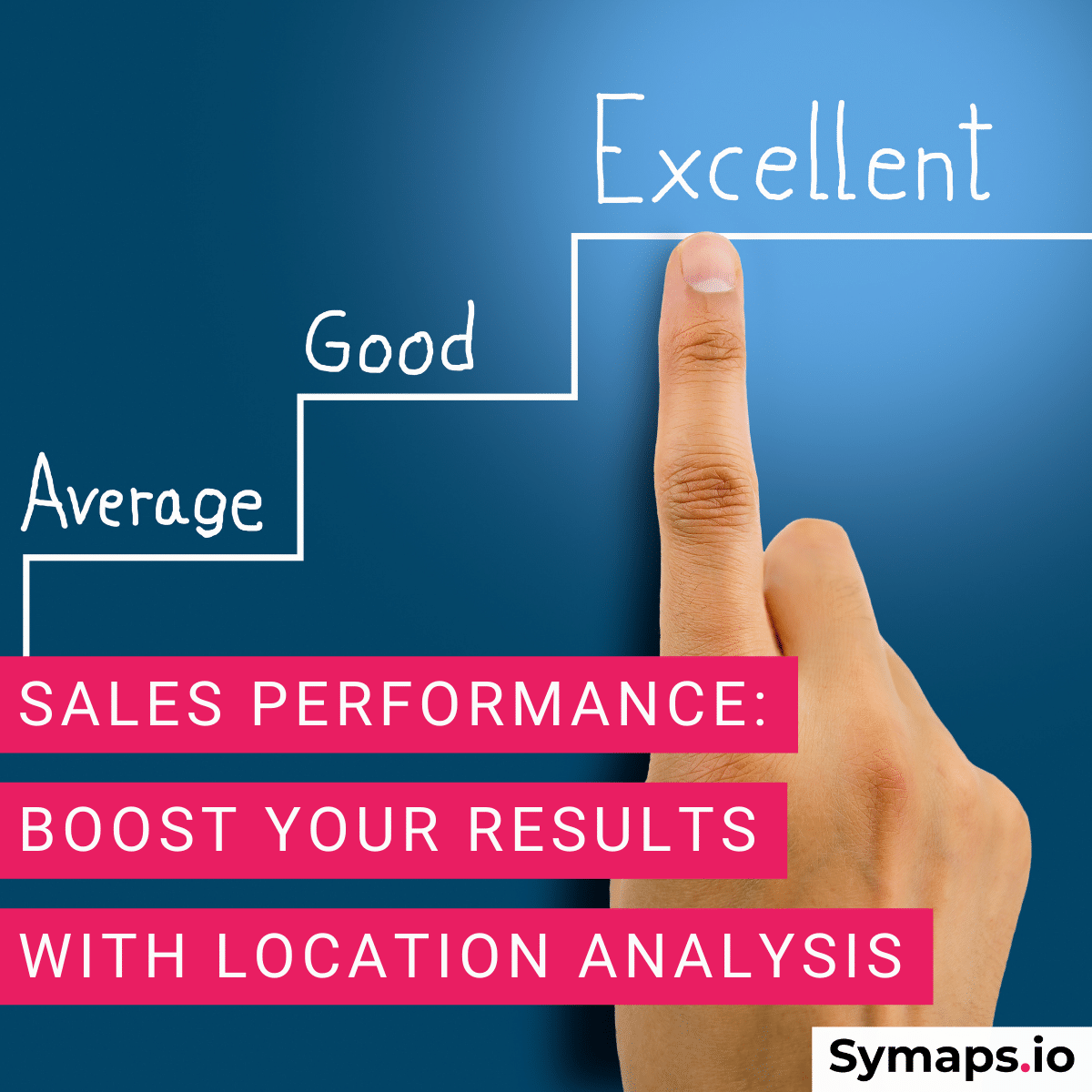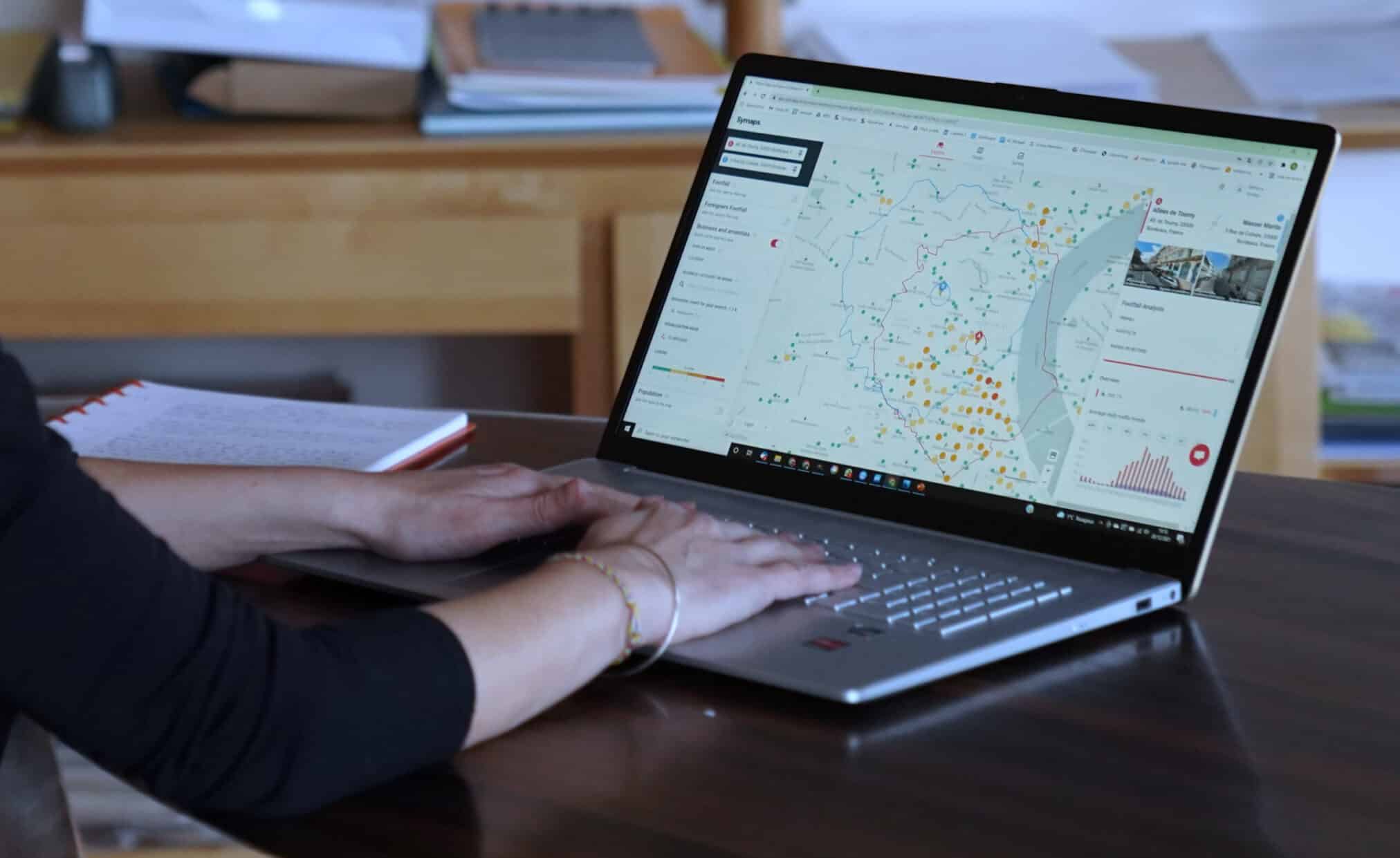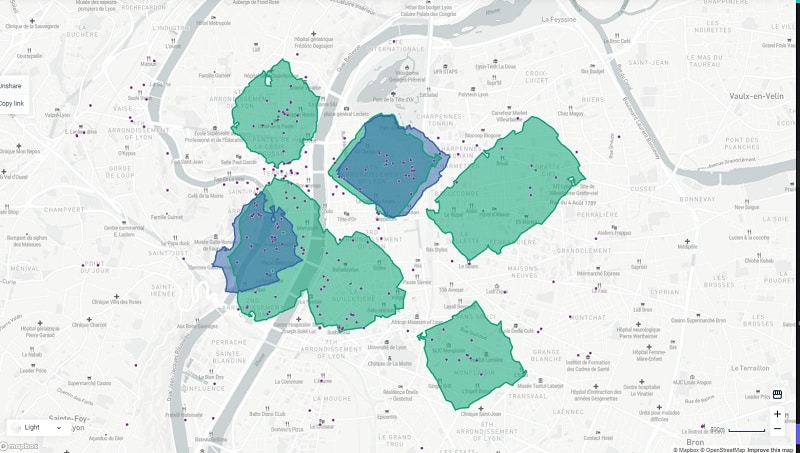Sales performance:
4 examples of how to boost your results with location analysis
Understanding sales results and customer behavior is key to improve sales performance and stay ahead of competition. Using sales performance-enhancing insights provided by location analysis, sales teams can create action plans that will maximize sales performance in the short-term and set up businesses for long-term success.
Find out how with four examples in this article.

Sales performance and location analysis: the basics
Before diving into details, let’s first take a moment to review and grasp the fundamental concepts of sales performance and location analysis.
Sales performance, in a nutshell, measures how effective an organization’s sales activities are. It serves as a critical metric for businesses that rely on revenue generated from sales. It involves an extensive array of key performance indicators (KPIs) used to measure sales performance, such as revenue, conversion rates, and customer acquisition cost. Businesses need to keep track and to analyze data regularly to establish clear objectives for their sales teams.
Location analysis refers to the collection and analysis of any type of data that is related to a specific geographical location.
This includes information on consumer behavior, market trends, and competitor activities, as well as other relevant data points.
Dedicated visualization and analysis tools such as Symaps facilitate the analysis and the identification of patterns and trends of location-based data.
Leveraging Location Analysis for Improved Sales Performance: 4 Examples
1. Improve your Marketing and Sales Efforts thanks to a Deeper Understanding of Customers Behaviors
To boost sales performance, businesses need to understand their customers. A good approach to that is to leverage geomarketing insights, which provides data about customers such as their locations, demographics, income levels, buying habits, interests, and activity indicators such as time spent at a location.
Analyzing this data makes it possible to find patterns that reveal valuable insights into customer preferences and behaviors. You probably don’t need us to give a general explanation as to why this kind of insights are valuable.
Let’s look at some examples instead.

A coffee chain can analyze consumer preferences and foot traffic based on their coffee shops locations. This will provide useful insights for better segmenting its marketing approach, such as identifying differences between coffee shops located in office areas versus residential areas. This will translate into tailored promotions, adjusted hours, product selection adaptations, and other relevant measures.
Similarly, retailers leverage geomarketing data to identify the geographic areas where their customers are most active and adjust their advertising to focus on those regions. By using geomarketing, businesses can create more effective sales and marketing strategies that are tailored to their customers’ needs and preferences, leading to better sales performance.
2. Benchmark Sales Success to create a profitable action plan
Benchmarking is a critical process for any business looking to improve its sales performance, and geomarketing can be used to benchmark on multiple levels.
Compare sales performance between different geographic areas
One way is to benchmark sales performance between different geographic areas, such as between stores or regions. With a geomarketing application, businesses can access data on sales performance for specific geographic regions and compare it to data from other areas. This allows sales managers to identify areas where sales are particularly strong, as well as areas where they may be falling short.
By comparing sales performance across different regions, they gain insights into which factors are contributing to success, such as local customer demographics, competition, or seasonal trends. You can then use this information to adjust your sales and marketing strategies in areas where performance is lacking, and replicate successful strategies in other areas.
To what extent are sales performance affected by location profile?

Armed with this detailed reporting, sales teams and company management have the information they need to identify high-performing and low-performing locations by comparing real-world results to these theoretical estimates. This makes it much easier to create effective action plans that result in improved sales performance to achieve consistent, sustainable growth.
For example, a retailer might compare actual sales results with the potential sales estimates for each of its stores, and then make changes to under-performing stores such as optimizing store layout or improving inventory management.
3. Target High-Potential Areas
Geomarketing and location intelligence tools are also a great way to help development teams target high potential areas—areas that show the greatest sales potential in relation to a sales team’s defined sales objectives.
One of the most important decisions a business can make is the choice of location for a new store or selecting the best reseller partners.
Geomarketing provides valuable insights into the local area that can help identify the best possible locations. By analyzing geodata such as foot traffic, population profile, and competitive environment, you can quickly identify areas that are likely to generate high levels of foot traffic and sales.
For example, If you’re opening a high-end gym, you likely require a very specific market to find lasting success—namely, a wealthy, active population. Using a location intelligence tool, you can easily filter potential areas by these filters (and dozens more) to land on a shortlist with high potential.
This targeting ability is also helpful for finding optimal locations within a network of existing locations, distributors, and retail partners—something that benefits indirect resellers in particular. Finding expansion partners can be difficult, but Symaps can help you quickly narrow down results based on factors like proximity to other locations and market potential —the tool will even find the best locations for you.
Book a Call with our Location Data Experts
for a Free Consultation on Your Sales Network!
Is your network properly sized?
How to optimize your coverage?
Which areas should you target first?
Contact our location data experts to see what location data can bring to your business.
4. Optimize Your Sales Resources
Location intelligence tools are valuable for businesses seeking to optimize sales resources by eliminating conflicts and finding synergies with the existing network.
For instance, sales teams can use a geomarketing application to evaluate the overlaps of sales locations that are in proximity to one another, thus sharing resources. Conversely, they can determine sales locations that are distant enough to avoid conflicts between sales reps.
These benefits also translate into more efficient marketing budgets, as your marketing efforts overlap with an increasing number of locations. By enhancing cash flow efficiency, this translates to more funds for improving your sales performance in the long run, such as investing in the quality of your products or services.
In essence, geomarketing and location intelligence are tools that improve the return on investment (ROI) of both sales and marketing activities.
5. Geomarketing tools
There are a variety of geomarketing tools available, including:
– Geolocation tools
Tools that enable businesses to target customers based on their location, such as GPS and Wi-Fi.
– Mapping and visualization tools
Tools that allow businesses to visualize and analyze geographic data, such as heat maps and demographic maps.
– Data analysis tools
Tools that enable businesses to analyze and interpret geodata, such as marketing analytics software and business intelligence tools.
Conclusion
In conclusion, using location analysis to gain insights into customer behavior, benchmarking sales success, and targeting high-potential areas helps businesses create more effective sales and marketing strategies.
Leveraging location analysis helps organizations gain a competitive edge, achieve sustainable growth, and ultimately, boost sales performance.
A specialized location intelligence application like Symaps supports businesses in analyzing data and gaining insights into their sales performance, leading to better decision-making and improved results.
Book a Call with our Location Data Experts for a Free Consultation
Site selection – Strategic planning – Coverage analysis – Network optimisation – Expansion simulations – Local market research
Is your network properly sized?
How to optimize your coverage?
Which areas should you target first?
Contact our location data experts to see what location data can bring to your business.
Share post


